Book contents
- Frontmatter
- Contents
- Series Foreword
- Acknowledgments
- How Students Come to Be, Know, and Do
- Introduction
- 1 The Context Lens
- 2 How Ways of Knowing, Doing, and Being Emerged in the Classroom: Interpersonal Interactions and the Creation of Community, Part I
- 3 How Ways of Knowing, Doing, and Being Emerged in the Classroom: Interpersonal Interactions and the Creation of Community, Part II
- 4 Personal Lens of Analysis: Individual Learning Trajectories
- Conclusion
- References
- Index
- Titles in the series
4 - Personal Lens of Analysis: Individual Learning Trajectories
Published online by Cambridge University Press: 06 December 2010
- Frontmatter
- Contents
- Series Foreword
- Acknowledgments
- How Students Come to Be, Know, and Do
- Introduction
- 1 The Context Lens
- 2 How Ways of Knowing, Doing, and Being Emerged in the Classroom: Interpersonal Interactions and the Creation of Community, Part I
- 3 How Ways of Knowing, Doing, and Being Emerged in the Classroom: Interpersonal Interactions and the Creation of Community, Part II
- 4 Personal Lens of Analysis: Individual Learning Trajectories
- Conclusion
- References
- Index
- Titles in the series
Summary
For whatever the art, the science, the literature, the history, and the geography of a culture, each man must be his own artist, his own scientist, his own historian, his own navigator. No person is master of the whole culture; indeed, this is almost a defining characteristic of that form of social memory that we speak of as culture. Each man lives a fragment of it. To be whole, he must create his own version of the world, using that part of his cultural heritage he has made his own through education.
(Bruner, 1966, p. 116)Our analyses now turn to catching students in the act of making their culture their own through their experiences in Mrs. Glenda's science classroom. In this chapter we plot students' evolution over time as they created and negotiated concepts and epistemological practices together with the emotional climate and distinctions of worth within their classroom. Students brought their own “history in person” (Holland, Lachicotte, Skinner, & Cain, 1998) as a starting point for improvising in this new classroom context.
We met the students at the classroom door and got to know them more through interviews and Mrs. Glenda's reflections. We had limited information about students' experiences in other classrooms and contexts outside of school. We followed how each student interacted with the new values and practices that were being introduced in the context of the study classroom.
- Type
- Chapter
- Information
- How Students Come to Be, Know, and DoA Case for a Broad View of Learning, pp. 148 - 190Publisher: Cambridge University PressPrint publication year: 2010



